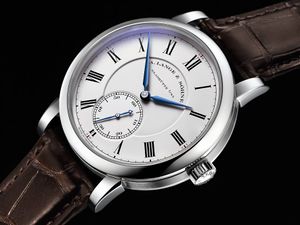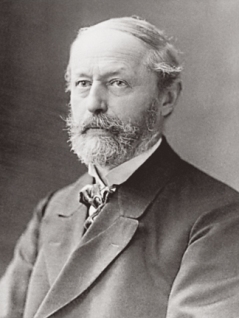Precise, Preciser, RICHARD LANGE “Pour le Mérite”
Precise, Preciser, RICHARD LANGE “Pour le Mérite”
| other languages: de |
Glashütte, January 2009
The third Lange wristwatch with a fusée-and-chain transmission continues the tradition of observation watches that are fully focused on precise time measurement. This horological rarity with its three-part enamel dial has famous historic forebears.
The pocket chronometer – the timepiece of the scientific elite – has always been a coveted rarity. It dates back to around 1880 at A. Lange & Söhne, when Richard Lange, the company founder’s oldest son and technical director of the family business, was already inspiring the craft of precision watchmaking. Overall, only about 30 of these unusual timepieces were ever made. Now, the chronometer with a fusée-and-chain transmission is experiencing a renaissance, as an exclusive timekeeping instrument for the wrist dedicated to mechanical precision – reduced to this sole purpose, without any further complications. Its name: RICHARD LANGE “Pour le Mérite”.
Following the TOURBILLON in the first collection and the TOURBOGRAPH presented in 2005, this RICHARD LANGE model also bears the distinction “Pour le Mérite”. At Lange, it is reserved for exceptional complications such as the fusée-and-chain transmission. It refers to the order of merit initiated in 1842 by the eminent explorer Alexander von Humboldt and which is still awarded to great scientists and artists. But this distinction could also be understood as a commendation for the forefathers of Saxony’s precision watchmaking industry. One of them is Richard Lange who enriched watchmaking with numerous inventions, most notably the steel-nickel alloy for balance springs that he patented in 1930. The alloy contains beryllium, making hairsprings thermally stable and resistant to magnetic fields. It is still widely used today for the same purpose.
The RICHARD LANGE “Pour le Mérite” is the second member of a watch family dedicated explicitly to greater precision in time measurement. The first watch with the same name, a large and extraordinary three-hand timepiece devoted to the tradition of scientific observation watches, was a role model of accuracy and lucid design. The new model also has a case in platinum or pink gold with a diameter of 40.5 millimetres, perceptibly enhancing legibility. Puristically organised, the radiant white three-part enamel dial features narrow black Roman numerals for the hours and small red Arabic numerals for 15, 30, 45, and 60 minutes. Thirty elaborate processes are needed to produce each of the three subsidiary dials. The result is an immaculate enamel face that sets a brightly contrasted stage for the classic blued-steel hands. An aperture in the dial that could have shown the fusée-and-chain mechanism from the front was deliberately omitted so that nothing would distract the owner from telling the exact time at a glance.
More Effective Than a Tourbillon
Thus, the second RICHARD LANGE also focuses the attention of its owner on the objective of all horological ambitions: the greatest possible degree of precision. It relies on an ingenious construction, a drive based on the chain-and-fusée principle used as early as the 15th century among others by Leonardo da Vinci. In his standard reference book “Watchmakers and Clockmakers of the World”, G.H. Baillie characterised it as follows: “Perhaps no problem in mechanics has ever been solved so simply and so perfectly”. However, it takes the ultimate in know-how and dexterity to craft this intricate mechanism in a size that can be accommodated by a wristwatch, so understandably, it is much rarer today than the tourbillon. At the same time, it is much more effective in a wristwatch because it overcomes the greatest disadvantage of the winding train – the unavoidable loss of torque – by intelligently harnessing the principle of levers.
The fusée-and-chain transmission compensates for the declining spring force, keeping the effective torque constant across the entire power-reserve period. For this purpose, the drive function, usually handled by the mainspring barrel alone, is taken over by two components: the mainspring barrel and the adjacent tapered fusée. The two components are connected by a dainty chain which in the case of the RICHARD LANGE “Pour le Mérite” consists of 636 individual parts. At one end, it is attached to the broad lower end of the fusée and at the other to the exterior of the spring barrel. A slot is milled into the conical surface of the fusée that leads to the narrowest point, much like a spiral path that leads to the summit of a mountain. When the watch is being wound, the chain unreels from the outer wall of the barrel and wraps around the fusée until – if we stick with our metaphor – it arrives at the summit of the mountain. In this state, the radius of the fusée, i.e. the magnitude of its leverage, is small but the torque delivered by the mainspring is large. As the mainspring gradually unwinds, its power diminishes. But as the chain unreels from the fusée and back onto the barrel, the length of its lever – the effective radius of the fusée – increases by the exact same measure as the spring’s torque decreases. The result is constant torque at the fusée’s arbor and therefore constant amplitude of the balance.

